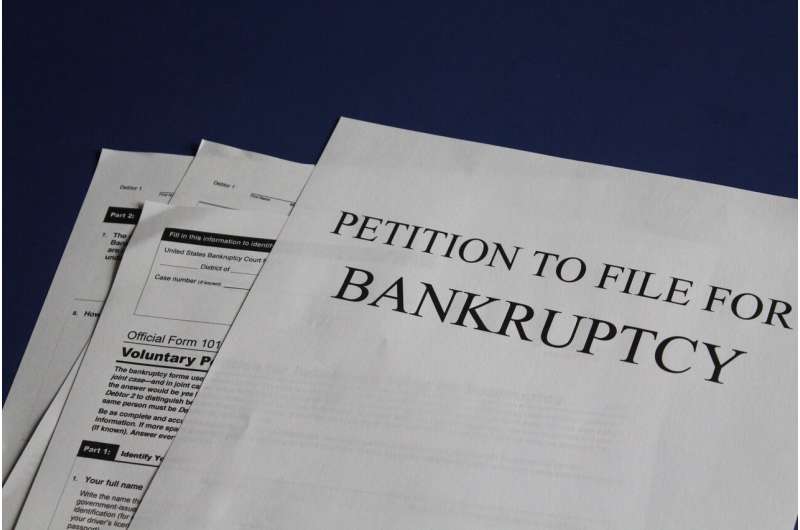Credit: Unsplash/CC0 Public Domain
A new paper co-written by a University of Illinois Urbana-Champaign expert who studies consumer credit issues provides the first comprehensive overview of bankruptcy filers in more than 30 years, shining a spotlight on the economic stressors faced by U.S. debtors.
An analysis of consumer bankruptcies from 2013-19 shows nine distinct patterns common to all filers—a finding that ought to afford policymakers a rough blueprint of how to make the current bankruptcy system more efficient and effective, said Robert M. Lawless, the Max L. Rowe Professor of Law at Illinois.
"One in 10 adults in the U.S. have turned to the consumer bankruptcy system for help, often after struggling for years to pay their debts," said Lawless, also the co-director of the Illinois Program on Law, Behavior and Social Science at the College of Law. "Many different types of people file for bankruptcy for a number of different reasons, but we have a bankruptcy law that is too much of a one-size-fits-all solution. We found that there is no typical bankruptcy filer, and the law needs to be adaptive to different situations—particularly to the nine distinct patterns that emerged in our data."
Lawless' co-authors are Pamela Foohey, of the Benjamin N. Cardozo School of Law, and Deborah Thorne, of the University of Idaho. Lawless, Foohey and Thorne also are co-principal investigators for the Consumer Bankruptcy Project, a long-term interdisciplinary research project that collects demographic data on U.S. bankruptcy filers.
Using principal component analysis, a statistical technique that exposes strong patterns in a dataset, the researchers combed through 5,600 randomly selected U.S. consumer bankruptcy cases compiled by the Consumer Bankruptcy Project.
"We've been using the bankruptcy system as a tool to examine the financial situations of U.S. households," Lawless said. "But after seven years of data collection, we thought it was time to take a step back and look at the big picture. And the big picture is complicated. There is no single archetype for bankruptcy filers in the U.S. There are, however, a number of distinct patterns, some of which overlap with each other."
The analysis suggests nine groupings of financial and household situations among bankruptcy filers: car owners, homeowners, Black households, women, Black women, single mothers, the self-employed, property owners and people who have long-term struggles with debt.
"Two of the bigger factors for bankruptcy were, as expected, homes and cars, because those are the two big-ticket items that consumers buy," Lawless said. "The idea of filing for bankruptcy for those items is so you don't lose them—so you're not homeless or are unable to get to work. The current bankruptcy system gives people powerful, effective tools to do just that."
But there is considerable overlap among the patterns, according to the research.
"These categories are not necessarily exclusive of each other; they tend to intersect and overlap in lots of ways," Lawless said. "Women and Blacks are disproportionately represented in the data relative to their percentage in the overall population, and the same could be said for Black women or divorced women with children. Some of those people also file to save their home or their car. People come to bankruptcy with more than one or two specific sets of financial issues on which their cases turn."
The findings also underscore deeper fault lines in the U.S. economy, the authors said.
"Bankruptcy law is an important part of the social safety net and it can help alleviate the financial fallout from poor circumstances," Lawless said. "But it's not a silver bullet in terms of solving one's financial problems or social problems in the country writ large. It certainly could be improved upon."
One particular improvement might be a move to more of an a la carte bankruptcy system, Lawless said.
"An improved consumer bankruptcy system would offer people the ability to tailor their cases to their primary debt-relief needs, which is what the Consumer Bankruptcy Reform Act of 2020 would allow filers to do," he said.
But the bankruptcy system as it's currently constructed won't resolve the root causes of people's financial distress.
"At its core, bankruptcy provides a discharge of debts, which allows people to plan for a better future," Lawless said. "The bankruptcy code has no effect on equal pay legislation, paid time off for working parents with children or the affordability of reliable child care. When people contemplate filing for bankruptcy, they're already in a deep financial hole. Many people's lives do not get sunnier in the years following their bankruptcies."
The paper will be published in the Georgia Law Review.
More information: Pamela Foohey et al, Portraits of Consumer Bankruptcy Filers in the United States, SSRN Electronic Journal (2021). DOI: 10.2139/ssrn.3807592
Provided by University of Illinois at Urbana-Champaign




















